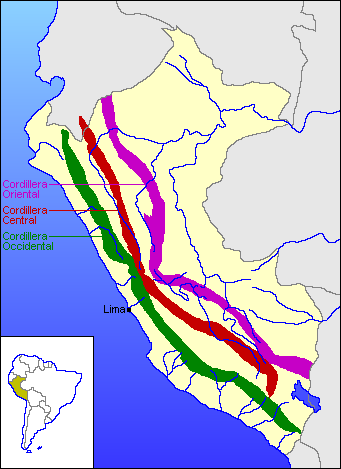Occurrence of Glaciers
Peru is located on the western side of South America between lat 0° and 18°S. and long 69° and 81°W.; it is traversed by the great Andean mountain system that extends along the entire western side of South America. Extensive areas of this mountain system are glacierized. The Peruvian Andes comprise three major ranges or cordilleras (see next figure):
- Cordillera Occidental on the west,
- Cordillera Central in the middle,
- Cordillera Oriental on the east.
The high average elevation of the three cordilleras, together with regional and local climatic conditions, has resulted in the extensive development of glaciers in many locations. In fact, the Peruvian Andes have the largest area of tropical glaciers on Earth. The total ice-covered area is estimated to be 2,600 km². The average minimum elevation of glaciers in Peru is 4,800 m above sea level (asl). In the discussion that follows, the glacierized areas have been grouped into 20 distinct cordilleras. Each of these areas is briefly described, first those in the Cordillera Occidental followed by those in the Cordillera Central and then those in the Cordillera Oriental. Within each cordillera, the areas are described from north to south. The largest single glacier, the Quelccaya ice cap, is in the Cordillera de Vilcanota. Of the next 11 largest glaciers, 8 are located in the Cordillera Blanca.




